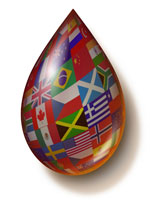The global lubricants market is flat, up only 1% with an estimated 39.1 million tonnes in 2013 compared to 38.8 million tonnes in 2012. In terms of lubricants volume consumed, the United States continues to be the largest country market, although its total global volume has now dropped from 25% to below 22%. Interestingly, Russia has surpassed Japan and is now the fourth largest country market. Both North America and Western Europe continue to stagnate below pre-recession levels. Though Asia and other developing regions picked up in 2011, the market lost steam in 2012, most notably in China, down 1.1%.
What are we to make of this information? Analyzing the finished lubricants business is a tricky endeavor, one made easier with the right tools. Kline’s tried and true LubesNet is a comprehensive database of finished lubricants demand. Now in its eighth year, LubesNet provides users with Kline’s estimates of lubricants demand from 2008 to the base year of 2013, as well as FutureView forecasts to 2017 and 2022. For a breakdown of data at the global, regional, country market, market segment, product type, product category, and viscosity grade levels, LubesNet is information at your fingertips.
Being armed with such information is critical to the success of your business. It is vital to understand the current market and, perhaps even more important, grasp the market’s future. For example, global lubricants demand is projected to grow at <2% per year to reach 42.1 million tonnes by 2017. Kline predicts that China will be the leading market by 2015/2016. In addition to volumetric growth, quality levels are also improving, offering opportunities for all industry players. Another observation made by Kline is that the continuing global migration to lower visgrade PCMO will result in higher penetration of synthetics, semi-synthetics, higher revenues, and conversely longer ODIs and lower overall PCMO demand. The use of lower visgrade PCMO varies considerably by country, presenting trends, challenges, and opportunities for all industry players. The bottom line is that the demand for high performance lubricants is expected to grow even faster in the future, in both developed and developing countries.
Kline is pleased to offer the eighth edition of its very comprehensive LubesNet, with supporting information for all 52 country markets. The database also includes estimated automotive and industrial lubricants supplier market share, synthetic penetration by leading lubricant type, vehicle parc size, and type and segmentation definitions. Subscribers to this service will experience many key benefits, including:
- FutureView forecasting tool: enabling users to override Kline’s base year and/or per annum growth rates to run their own “what if” scenarios
- Trend View: providing a complete view of lubricants demand from 2008 to 2022 to understand how a country market is evolving from low margin to higher margin products
- Kline’s supplier market share estimates at the country level: helping with entry strategies to identify key competitors including global majors, national oil companies, public sector undertakings, and regional and independent suppliers
The newest improvement to these key benefits is a completely new look and level of functionality for a truly customizable data search and analysis. This edition’s improvements over the previous edition include ease of use, functionality, and customizability. For example, for those needing to understand the growth rate for synthetic OW-XX PCMO in Thailand, there is no better source than Kline’s searchable LubesNet database.
Information like this is what makes LubesNet the definitive source for identifying and quantifying industry trends and opportunities for global, regional, and independent lubricant and additive suppliers. To learn more about the benefits of subscribing to LubesNet, please visit /reports/lubricants_industry_database.asp.
To order LubesNet, please visit /reports/lubricants_industry_database_form.

